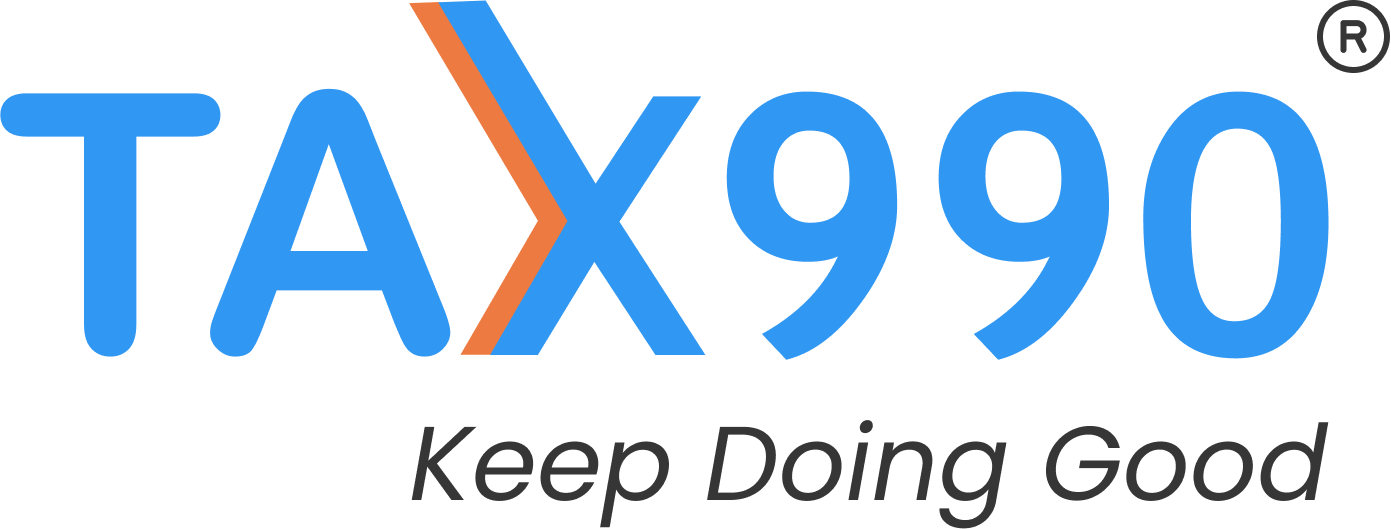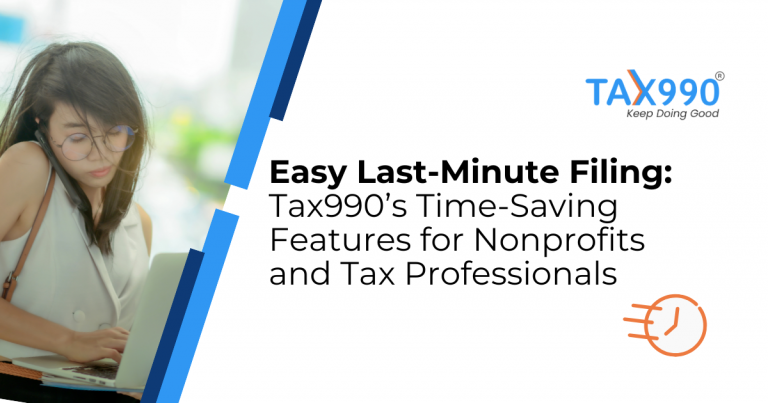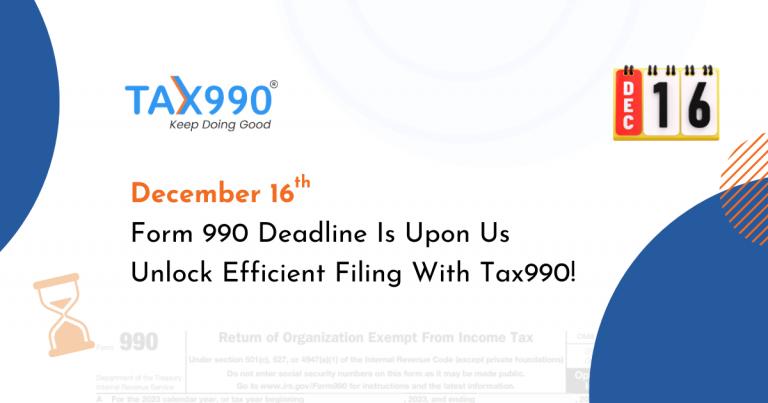Meeting Today’s November 990 Deadline: A Comprehensive Guide for Nonprofits
Estimated reading time: 22 minute(s)
Today is a major deadline for filing 990 forms for nonprofits. Filing a Form 990 is an essential annual responsibility for every nonprofit organization aiming to maintain its tax-exempt status. Beyond tax compliance, Form 990 provides a summary of the organization’s mission, accomplishments, and financial health to both the IRS and the public. By understanding its significance and completing it accurately, nonprofits demonstrate transparency, reinforce trust, and avoid potential obstacles to staying compliant.
Here’s a guide to help you navigate through this November 15 deadline seamlessly.

Key Considerations Before You Start Filing:
Understanding the IRS Tax Compliance for Nonprofits
Even though nonprofit organizations are tax-exempt under IRS section 501(c), they’re required to file 990 forms annually. Nonadherence to these filing requirements could cause significant penalties ranging from $20 – $120 for each day based on the organization’s profile. Failing to file persistently for 3 years could result in the revocation of your organization’s tax-exempt status.
Determine Which Version of Form 990 Your Nonprofit Needs to File
Choosing the right version of Form 990 is essential to remain compliant and avoid unnecessary workload. The specific form depends on the nonprofit’s financial profile:
- Form 990-N (e-Postcard): For nonprofits with gross receipts of $50,000 or less.
- Form 990-EZ: For organizations with gross receipts under $200,000 and total assets under $500,000.
- Form 990: This form applies to larger nonprofits with gross receipts more than or equal to $200,000 (or) assets more than or equal to $500,000.
- Form 990-PF
This form is designated explicitly for private foundations to report their annual activities. - Form 990-T
If your organization has an unrelated business income (UBI) of $1,000 or more, you must file Form 990-T.
Note: Organizations eligible to file Form 990-N may also opt to file Form 990-EZ or the complete Form 990 if they prefer. Similarly, if you are required to file Form 990-EZ, you may file Form 990 instead, but not the other way around.
Conduct a Thorough Financial Review and Organize Supporting Documentation
Adequate preparation for Form 990 begins with a detailed review of your organization’s finances. This includes:
- Revenue and expenses: Break down all sources of income and expenditures by category.
- Grants, donations, and contributions: Document all forms of funding, including donor information and grant details.
- Investments, assets, and liabilities: Record the organization’s assets (such as investments, property, and equipment) and any liabilities.
- Compensation records: Ensure you have clear documentation for all salaries, benefits, and payments made to staff, board members, and contractors.
Tips To File a Complete Form 990:
Address Governance and Organizational Structure
The IRS is particularly interested in a nonprofit’s governance practices, which must be reported on Form 990. Nonprofits that demonstrate proper governance practices often build greater trust among their stakeholders. This includes:
- Board composition: List current board members and provide their roles and responsibilities.
- Policies: Report on policies covering every aspect the IRS demands.
- Maintain Formal Records: Maintain and provide records of board and committee meetings, which reflect the organization’s decision-making process.
Highlight Program Service Accomplishments
One of the most critical sections of Form 990 requires nonprofits to outline their primary program accomplishments. For each program:
- Describe program activities: Explain how each program fulfills your organization’s mission.
- Show impact through metrics: Include specific numbers and data that demonstrate the reach and effectiveness of each program (e.g., number of individuals served, resources distributed).
- Include financial details: Document the expenses allocated to each program, illustrating how funds are used to drive impact.
- Ensure the Balance Sheet Is Precise
Completing the Form 990 balance sheet can be complex as it involves numerous data and calculations. This section requires the utmost focus and time, as it requires detailed computations that give a snapshot of the organization’s financial structure. Here are some tips to complete the balance sheet effectively:
- Balance the Data at the Beginning and End of Tax Year: Verify that the beginning and ending balances align with prior years. Discrepancies can indicate accounting errors or rejections.
- Make Sure the Data Are Legit: Make sure your entries align with the organization’s financial documents. Even a minute error could raise inquiries during IRS review.
- Check for Completeness and Accuracy: After completing, review every entry, making sure it is accurate and complete.
To learn more about how to complete the balance sheet, click here.
Common Mistakes to Watch Out For:
Attach All Required Schedules
Schedules are supplementary forms that provide additional details to support the information on your 990 form. With 16 different types of 990 schedules, each serving a unique purpose, it’s essential to attach the correct schedules and fill them out accurately. Missing any necessary schedule can cause your 990 return to be incomplete.
Make Sure You’ve Acquired Signature Authorization
The IRS insists you authorize the tax preparer and e-file providers to file on behalf of your behalf. If you’re filing for your clients, make sure you’ve acquired the signature authorization from the concerned signatories. Below are the signature authorization forms:
- Form 8879-TE: This form grants permission to the Electronic Return Originator (ERO) to file on behalf of the organization and to authorize electronic funds withdrawal, if necessary. This form is retained by the ERO and not submitted to the IRS unless requested.
- Form 8453-TE: This form is used to authorize online filers, paid preparers and CPAs to prepare and file IRS forms on behalf of their clients. – make it clear and correct the flow
- Review for Common Errors and Double-Check Information
Mistakes in Form 990 filings are more common than you might think and can lead to delays, rejections, or penalties. Consider the following before submission:
- Inconsistencies with other filings: Make sure your numbers align with your audited financial statements and any other IRS filings.
- Double-check for required details: Double-check that all relevant sections are filled out, including program accomplishments, board member names, and compensation figures.
- Get Reviewed with Concerned Authorities: Make sure your return got reviewed by concerned authorities and clients before submission.
- Submit Form 990 by the Deadline or File for an Extension
The IRS deadline for filing Form 990 is typically the 15th day of the 5th month. Missing this deadline can lead to penalties, with continued non-compliance potentially resulting in the revocation of tax-exempt status. If your organization needs more time, you can file Form 8868 to request a six-month extension.
Choose a Reliable E-File Provider
Since the IRS now mandates electronic filing for all 990 forms, selecting a reliable e-file provider is crucial, as it could significantly facilitate your filing obligation. Look for an e-filing solution that:
- Authorized by the IRS
- Complies with IRS standards
- Supports all necessary forms and schedules
- Provides dedicated customer service
- Upholds high data security standards
Tax990, an IRS-authorized provider trusted by thousands of nonprofits, offers a reliable and streamlined solution for e-filing 990 returns. With its comprehensive features, Tax990 automatically includes required schedules with your 990 forms at no extra cost, simplifying your filing experience.
The Bottom Line
Accurate Form 990 filing is more than just a compliance task. It reflects your nonprofit’s transparency and commitment to its mission. By following these best practices, your organization can navigate the complexities of Form 990 filing with confidence, maintain IRS compliance, and reinforce public trust.





Leave a Comment